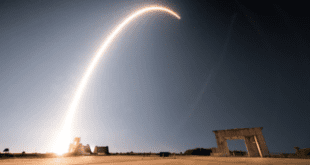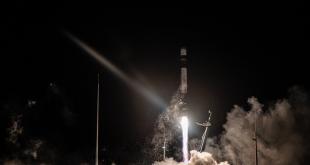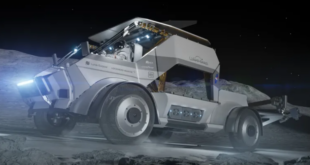By Delyan Momchilov

Marketing in outer space seems like an innovative idea, but it has 60+ years of history. Dr. Wernher von Braun, former Marshall Space Flight Center Director, pointed out on July 22, 1969: “Because without public relations we would have been unable to do it”. Today, accelerated access to space provides unprecedented opportunities for advertising stunts and viral marketing. Some campaigns raise ethical, environmental, and regulatory concerns, while others champion sustainability.
Now let’s take a deep dive into 10 of the most iconic space marketing campaigns ever made. This is not a quality ranking, but rather a chronology of creativity, curiosity, and sometimes a lack of common sense.
-
TOSHIBA
In 2009 Toshiba made a pitch for their marketing agency and London-based Grey won it. The task was to develop the image of Toshiba as an innovative company and allegedly the allocated budget was around 25,000,000 pounds. The focus product was the REGZA SV LCD TV, the most advanced Toshiba TV ever. Months later, at the home of Burning Man, the Black Rock Desert the creative agency redefined the armchair viewing. A living room chair was launched towards the edge of space via helium construction. The launch reached 98,268 feet (29,952 m) and set a world record for Highest High-Definition Television Commercial. The chair took 83 minutes to reach the maximum altitude and just 24 minutes to fall back to Earth. The whole event was filmed with a Toshiba camera. The campaign engaged its audience with a website, which offered the consumers the opportunity to win the REGZA SV LCD TV by guessing where the chair would land. There are no financial results published, but the campaign is considered a success in bringing to life Toshiba’s brand philosophy of leading innovation. Watch the record-breaking armchair here.

-
TNUVA
In 1997, Tnuva, a dairy company, carved its name in the history of advertising with the first-ever commercial filmed in orbit. The “Milk in Space” ad features astronaut Vasily Tsibliyev sipping Tnuva Milk in microgravity inside the Mir space station. The initiative sparked controversy, as it was done just a month after a collision between the Mir space station and the Progress M-34 supply ship. We have no data on Tnuva’s ROI in this venture, at least the brand holds the Guinness World Record for the first advertisement shot in space.

-
KFC
Zinger-1 mission was the promo campaign for establishing the flagship sandwich on the US market. The fried chicken filet, lettuce, and mayonnaise sandwich was launched with a helium-filled device called “the stratolite”. The campaign included a mission control website, social media live streaming, and selfies, captured by a robotic arm. The highlight is a meteorite shaped like a chicken sandwich. It was listed for $20,000, and it took just several days to find a buyer.


The Zinger-1 mission marks KFC’s second attempt into space marketing. Back in 1986, the Kentucky-based company sponsored a student-designed payload named “Chix in Space.” This experiment aimed to study chicken embryos in microgravity. Half the embryos were fertilized nine days before launch while the other half were fertilized only two days before launch. A week after returning to Earth, one of the eggs hatched. The chick was named Kentucky and lived out the rest of his days at the Louisville Zoo in Louisville, Kentucky.

-
TANG
TANG, the orange-flavoured sugar powder is the brand that started space marketing more than 60 years ago. It is unclear how it was concluded that a drink powder with low nutritional value was exactly what astronauts in space needed. Let’s put it in context, in the 60s doctors were still endorsing cigarettes as a remedy. The company took advantage of its product inclusion in the Mercury Flight and seized the communication opportunity. The product wasn’t designed for space travel, but space travel made it popular around the globe. TANG capitalized on the rising interest in early human space flight with ads like “For Spacemen and Earth Families”. It was used for more than a decade in space and was on board the Gemini and Apollo programs. As a result, there’s been a long communication misconception that TANG was developed for NASA. Here is their video advert from 1966.

Space isn’t a playground for flashy marketing.
-
Coca-Cola vs Pepsi
In 1984, a team of marketers and researchers for Coca-Cola got the idea to send the notorious can into space, providing astronauts with the pleasure of “feeling like home”. The added value for the brand was to generate content of the crew drinking from the specially designed branded dispenser. After a year of R&D and heavy investment, Coca-Cola had finally finished the zero-gravity Coke can and was eager to write history.

Somehow the secret project was revealed by Pepsi. The company booked a slot on the same space flight with Coca-Cola – the STS 51-F mission. Both drinks were tested in orbit, as Coca-Cola claimed to be the first fuzzy drink to be consumed in space. In a zero-gravity environment, carbonated beverages can be difficult to drink because the gas bubbles do not rise to the top of the liquid which can cause upset in the astronaut’s stomach. After the mission and major investments from both companies, none of their products were included in the menus of the next launches.

-
Humanity’s Star
In 2018, Rocket Lab designed and launched from their launchpad in New Zealand an extraordinary geodesic sphere. Humanity Star was made of carbon fiber and equipped with 65 highly reflective panels. Visually similar to a disco ball, it orbited the Earth every 90 minutes. Due to the highly reflective surface, the sphere was claimed to be visible to the naked eye at dawn and dusk.

Humanity Star is claimed to be the first satellite crafted with the sole purpose of building international unity through visual sightings. According to Rocket Lab, the project was designed as a reminder to all on Earth about our fragile place in the universe. The publicity/awareness campaign sparked debate on Earth and was labelled as “space graffiti”. Humanity Star has triggered astronomers as it didn’t fulfil the expectation of being easily visible. However, the campaign was a global sensation and sparked debate about light pollution.

-
Red Bull Stratos
Below the Karman line, but regarded as one of the most epic stunts of all time. On 14 October 2012, Austrian skydiver Felix Baumgartner jumped from 39 km, with 9.5 million people watching online. According to YouTube, the jump set a record for the “live stream with the most concurrent views ever on YouTube. The aim was to become the first human to travel at the speed of sound without an aircraft. It took Felix just 34 seconds to go supersonic, as he reached a top speed of 1,358 kph. The balloon that took him up was gigantic, the size of 33 football pitches and twice as high as the Saturn V rocket that was used for the Apollo missions. Besides the marketing dividends of Red Bull, the project aimed to test the safety of space professionals as well as potential space tourists.

Red Bull Stratos sought to surpass human limits and advance scientific discoveries to the benefit of humankind. The mission broke World Records and provided valuable scientific data for future pioneers and daredevils at the stratosphere and above.

-
TESLA
Tesla is famous for their zero-dollar marketing budget. Elon trusts his craftsmanship and charisma to trigger media and amplify his brand’s perception with one sentence.
“I love the thought of a car drifting apparently endlessly through space and perhaps being discovered by an alien race millions of years in the future”
In 2018, his personal midnight cherry Tesla Roadster was launched into space via Falcon 9. The campaign was tailor-made to attract the attention of space enthusiasts from around the world and it featured several Easter Eggs. Notable mention for the “Star Man”, a full-scale human mannequin in a SpaceX pressure spacesuit in the driver’s seat, the “DON’T PANIC!” message, which is a reference to the “Hitchhiker’s Guide to the Galaxy”, copy of the classic, Asimov`s Foundation trilogy on a 5D optical disc and “Space Oddity” by David Bowie looping on the radio.

Advertising Age agreed with Business Insider that the Roadster campaign was the “greatest ever car commercial without a dime spent on advertising“, demonstrating that Musk is “miles ahead of the rest” in reaching the younger generation. Currently, the “Star Man” is orbiting the Sun. How cool is this?

-
Columbia x Intuitive Machines
Intuitive Machines recently tested the innovative fabric of the sportswear brand Columbia on the Moon. The Omni-Heat™ insulation technology is used to protect the Nova-C lunar lander from the extreme temperatures of outer space. It is hostile out there, between -120 and +120 degrees Celsius. What better way to promote the temperature resistance of your sportswear? The scientific objectives of the mission include studies of plume-surface interactions, radio astronomy, and space weather interactions with the lunar surface.


As part of the initiative, the companies teamed with Embry-Riddle Aeronautical University to support outstanding women in STEM. The “Intuitive Machines and Columbia Sportswear Advancing Women in Technology Program” at Embry-Riddle Aeronautical University, Electrical Engineering & Computer Science Department will provide scholarships and fellowship opportunities for undergraduate and graduate students in STEM-related fields. The collaboration between Intuitive Machines and Columbia Sportswear Company successfully mixes science, bold marketing, and provides educational opportunities on Earth, which makes it a standout example of how to create a sustainable campaign in space.

-
OMEGA
In the 1960s, NASA began its search for a reliable timepiece for astronauts to use in space and to serve as the official watch of the program. Wristwatches by Rolex, OMEGA SA, Longines, Bulova, and Hamilton were put to torturous tests. On June 1st, 1965 the Omega Speedmaster Professional (Ref. 105.003) received the official NASA certification for use in manned space missions. It was the only wristwatch to pass. Since then, the Speedmaster has been worn on all six lunar landings including Apollo 12, 14, 15, 16, and 17.

Only 12 men have walked on the moon and each of them wore a Speedmaster. Reasonably the wristwatch won the nickname “Moonwatch”. Legend has it that it was Buzz Aldrin the first to wear the Omega on the Moon and not Neil Armstrong. The iconic steps of Buzz were later engraved in a limited edition of the Speedmaster.

This iconic association with space exploration solidified Omega’s status as a symbol of endurance, reliability, and high performance under the most extreme conditions. Today the “Moonwatch” is still trendy despite the emergence of smartwatches which on a practical level, offer more features. Recently The Swatch Group (owners of Omega) pulled off a marketing masterclass with the collaboration between their budget-friendly watchmaker company Swatch Ltd.. The co-branded series titled “MoonSwatch” created a worldwide frenzy. Last year, Swatch Group CEO, Nick Hayek announced that the company sold over 1,000,000 Omega x Swatch watches.

Acknowledging the significance of sustainable practices on Earth and beyond, Omega prioritizes the use of eco-friendly materials and processes. The brand is dedicated to actively reducing carbon footprints, responsibly sourcing materials, and implementing recycling initiatives to minimize waste and protect natural resources. Celebrated on Earth and beyond, the “Moonwatch” by Omega remains the true icon in the world of watchmaking and space marketing.


Space isn’t a playground for flashy marketing – it’s a delicate ecosystem that deserves our respect and sustainable approach. Environmental concerns are not confined to Earth alone. According to ESA, there are over 130 million space debris objects from greater than 1 mm to 1 cm. This is a result of human activity and poses a significant threat to the space environment. International and national regulations have been created to mitigate the risk of advertising contributing to space debris. On a commercial level companies are uniting efforts to tackle the problem. Notable mention for Vyoma Space and EnduroSat who announced the launching of a space debris-monitoring constellation. It is Europe’s first commercial mission for in-situ space situational awareness (SSA) and an excellent example of a sustainable collaboration for the better of mankind.
Some campaigns raise ethical, environmental, and regulatory concerns, while others champion sustainability.
It becomes imperative to design marketing campaigns that commit to keeping space pure. Only by balancing innovation with care for the cosmos, we can build a sustainable legacy for the generations to come. The time is now.

Disclaimer: This article is intended for educational purposes only. Images and statements used from external sources have been credited. The inclusion of such materials is for analysis and commentary and is by fair use principles. The views and opinions expressed in this article are those of the author and do not necessarily reflect the official policy or position of any referenced brands or organizations

Delyan Momchilov has 10 + years of experience in communications and marketing. He has led projects and teams for major companies in R&D, space tech, and education. He is a devoted promoter of space and health innovations, ex. Marketing Lead of EnduroSat and Space Challenges Program, author, and TED lecturer
 SpaceWatch.Global An independent perspective on space
SpaceWatch.Global An independent perspective on space




